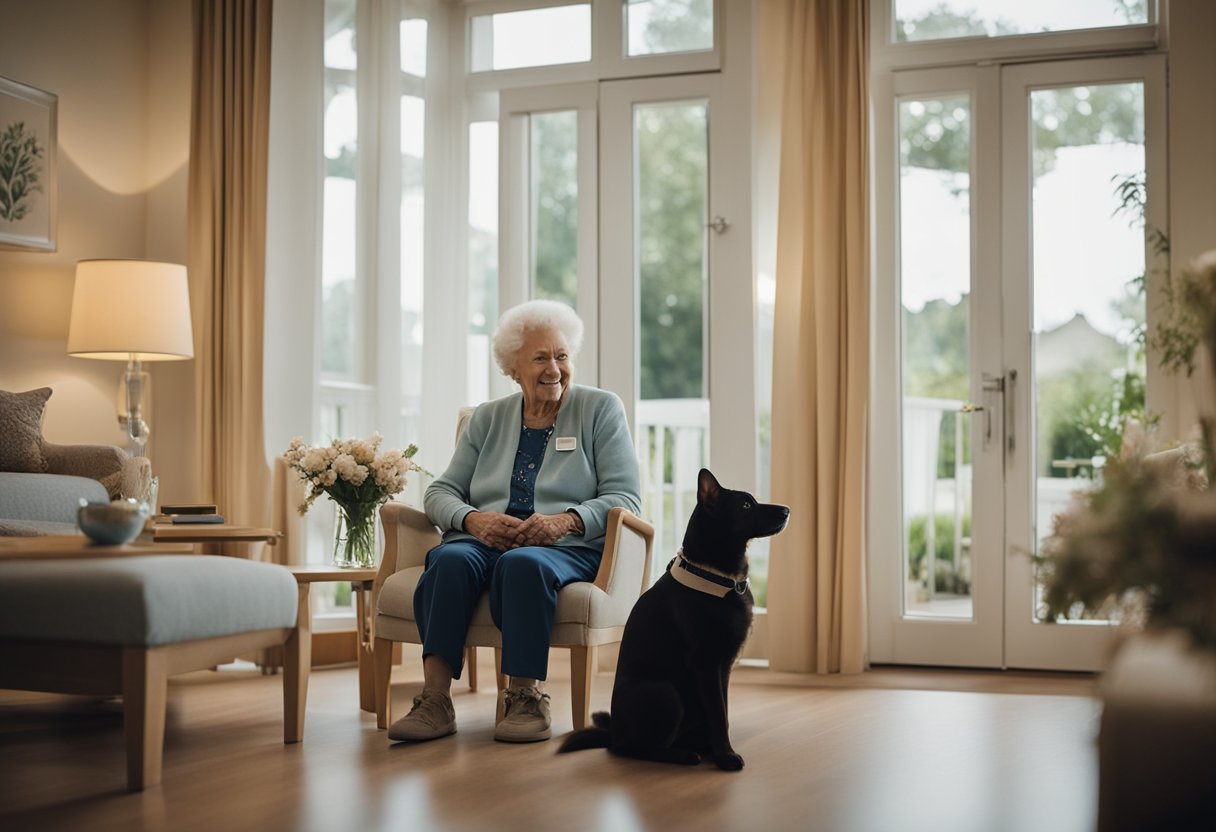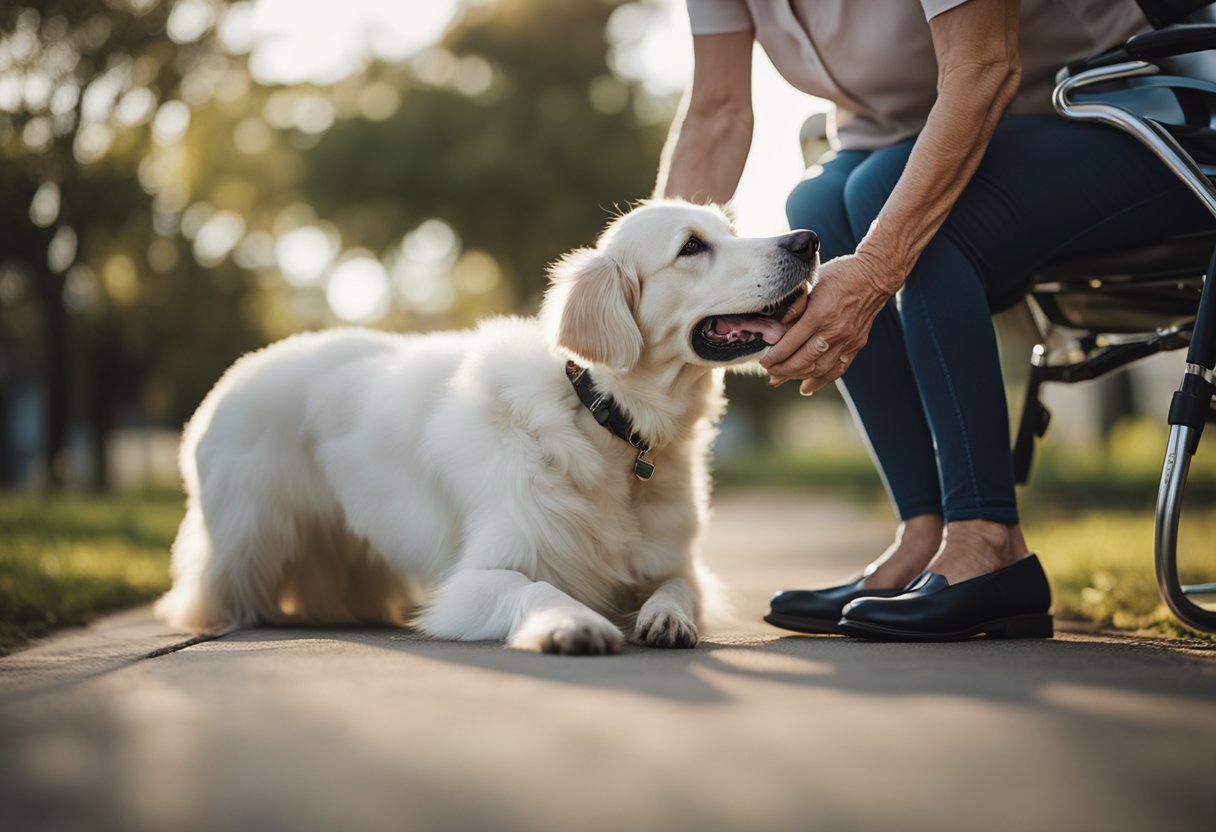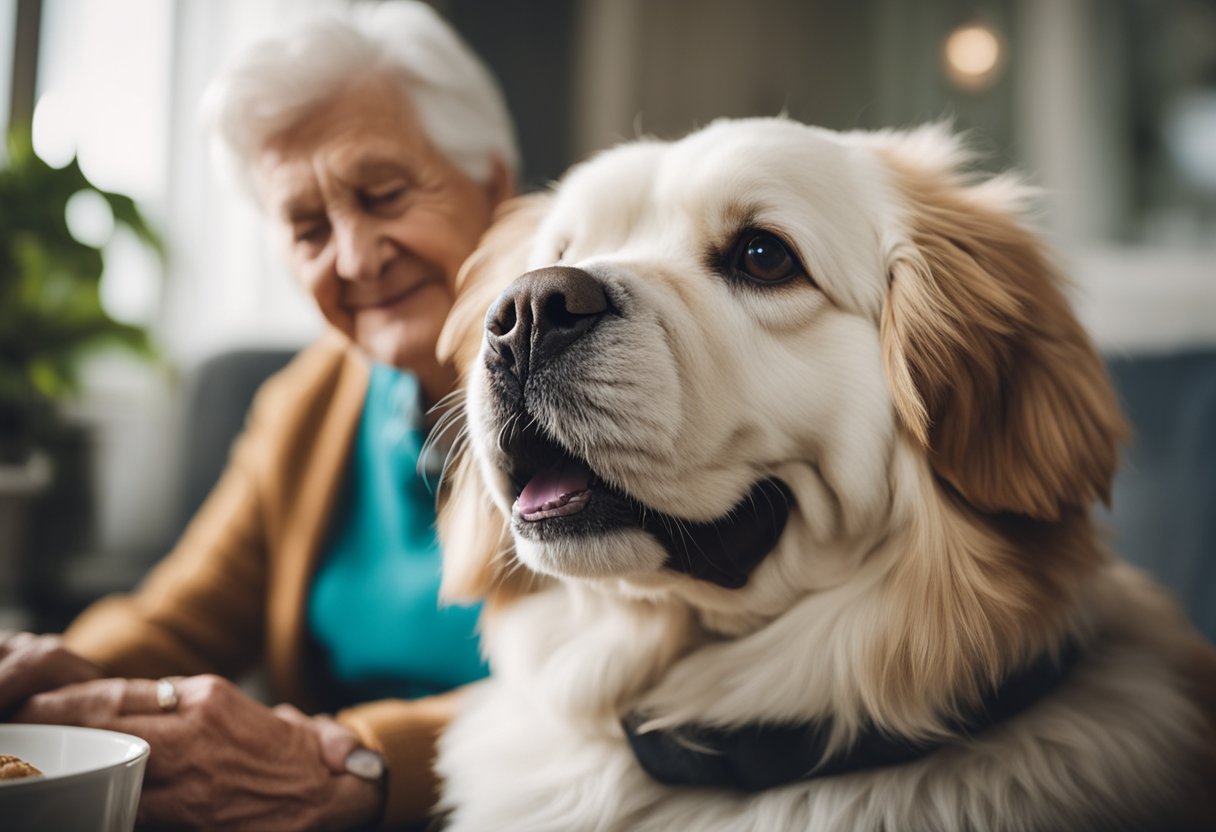Pet therapy, also known as animal-assisted therapy, has gained recognition as an effective non-pharmacological treatment for many patients, including seniors. It is a goal-oriented intervention in which animals are employed to help individuals cope with health challenges and social isolation. As the elderly population continues to grow, concerns about mental and emotional well-being have risen, prompting the exploration of alternative therapies to boost the quality of life.

Therapy animals can provide seniors with companionship, mental stimulation, and physical assistance, reducing conditions such as depression, anxiety, and loneliness. Primarily, therapy animals, such as dogs, cats, and even smaller creatures like guinea pigs or birds, have been observed to bring about substantial positive impacts in seniors’ lives. The various roles these therapy animals play and the types of settings in which pet therapy can thrive are crucial aspects to examine.
Understanding the benefits and responsibilities of pet therapy can help individuals make informed decisions about getting involved and choosing the right therapy animal. While there are some precautions to consider, such as allergies and the potential for injury, the profound psychological and emotional benefits seem to outweigh these concerns. Evaluating the costs and frequently asked questions also assists in navigating the exciting world of pet therapy.
Highlights
- Pet therapy can improve mental and emotional well-being for seniors.
- Various therapy animals can provide companionship and assistance in different settings.
- Informed decisions about involvement in pet therapy should consider benefits, precautions, and costs.
Understanding Pet Therapy
Pet therapy, also known as animal-assisted therapy, is a therapeutic approach that incorporates animals into various treatment plans. The involvement of therapy animals, particularly therapy pets, has shown positive effects on the physical and mental well-being of seniors.
One of the main aspects of pet therapy is the interaction between seniors and therapy animals, which can range from dogs and cats to smaller animals like rabbits or birds. These therapy pets are specifically trained to provide a calming and soothing presence, helping seniors cope with feelings of loneliness, stress, and anxiety.
Therapeutic Paws of Canada is a notable organization that aims to improve the quality of life for seniors through the help of volunteer therapy animal teams. These teams make regular visits to nursing homes, hospitals, and other facilities where seniors may benefit from the healing presence of a therapy pet.
The benefits of pet therapy for seniors are numerous. Studies have shown that interactions with therapy animals can help lower blood pressure, decrease heart rate, and reduce the production of stress hormones. Additionally, pet therapy has been found to improve seniors’ mental health by increasing social interaction and reducing feelings of isolation.
In conclusion, pet therapy has proven to be a valuable tool in enhancing seniors’ overall well-being. With the support of dedicated organizations like Therapeutic Paws of Canada, animal-assisted therapy will continue to improve the lives of seniors in need.
Benefits of Pet Therapy for Seniors

Pet therapy, a type of intervention wherein animals provide companionship and emotional support, has been gaining popularity for improving seniors’ well-being. This section explores the various mental, physical, and emotional benefits of pet therapy for seniors.
Mental Benefits: Engaging with animals can help reduce stress, anxiety, and depression in older adults. The simple act of petting and interacting with animals provides a sense of comfort, which can have a positive impact on mental health. Additionally, pet therapy may help improve memory, cognitive function, and self-esteem in seniors, as well as mitigate the symptoms of illnesses such as Alzheimer’s disease.
Physical Benefits: The presence of animals can promote physical activity in seniors. Regular interaction with pets can help improve motor skills, lower blood pressure, and overall enhance physical wellness. Moreover, research has shown that engaging in pet therapy may alleviate pain, speeding up recovery from illnesses or surgeries.
Emotional Benefits: Loneliness and social isolation are significant concerns for seniors, which can significantly impact their emotional well-being. Pet therapy helps address this problem by providing seniors with much-needed companionship and fostering social interaction. Emotional support animals, in particular, can help seniors maintain a more balanced emotional state, reduce stress levels, and improve their overall emotional health.
In conclusion, pet therapy can offer numerous mental, physical, and emotional benefits for seniors, enhancing their quality of life and well-being. With a wide-ranging impact on important aspects such as mental health, physical activity, and social engagement, it’s no wonder that pet therapy is a crucial intervention for improving the lives of older adults.
Types And Roles Of Therapy Animals

Therapy animals have increasingly gained recognition for their ability to improve the mental and emotional well-being of seniors. They come in various types and species, each offering unique benefits to older adults. This section will provide an overview of the common types of therapy animals and their roles in senior care.
Dogs are the most well-known therapy animals. Known for their loyalty, love, and ability to form strong emotional bonds, therapy dogs can greatly benefit seniors by providing companionship, reducing anxiety, and promoting physical activity. Many breeds of dogs can become therapy dogs, as long as they possess the right temperament, including good manners, obedience, and adaptability. Not to be confused with service dogs, therapy dogs are specifically trained to provide psychological support and comfort to those in need.
Cats also serve as therapy animals for seniors, offering a comforting and low-maintenance alternative to dogs. Their calming presence and gentle purring sounds can help reduce stress and anxiety among older adults. Some facilities and programs even use cats to encourage interaction and socialization among their residents.
Horses play a unique role in the realm of animal-assisted therapy. Equine therapy has been shown to benefit seniors in many ways, including improving balance, mobility, and coordination. Additionally, the strong bond formed between a senior and a horse can boost their confidence and self-esteem.
Birds might not be as commonly associated with therapy, but they can bring joy and companionship to seniors as well. Parakeets, cockatiels, and even chickens have been used in therapeutic settings, offering a sense of connection and purpose for older adults through their care and interactions.
In conclusion, the use of therapy animals in senior care encompasses a wide range of species, each with its unique benefits. Dogs, cats, horses, and birds all have their distinct roles in promoting the mental, emotional, and physical well-being of seniors. By understanding these roles and selecting the appropriate therapy animal, older adults can experience an enhanced quality of life and enjoy the many benefits of this special companionship.
Getting Involved In Pet Therapy
Pet therapy has proven to be an effective method in enhancing the overall well-being of seniors. Volunteering for pet therapy programs offers people a great opportunity to contribute to the happiness and health of the elderly population. This section will discuss how you can get involved in pet therapy, as well as the responsibilities that come with volunteering in this field.
One of the first steps to become a pet therapy volunteer is finding suitable locations that cater to the elderly, such as hospices, nursing homes, senior living communities, long-term care facilities, and retirement homes. These establishments often welcome pet therapy programs as they recognize the positive impact of animal companionship on their residents.
Upon selecting a facility, a potential volunteer should reach out to the corresponding staff members to inquire about the specific requirements, training, and certification process for pet therapy volunteers. Many organizations have their specific guidelines and rules that must be followed to ensure the safety and comfort of both the seniors and the therapy pets.
Volunteers are expected to bear a significant responsibility when participating in pet therapy sessions. They must ensure that the therapy pets are well-mannered, clean, and obedient, as well as up-to-date with their vaccinations. Additionally, volunteers should be prepared to handle any unexpected reactions or situations that may arise during the interaction between seniors and therapy pets, such as anger or extreme emotions.
It is also essential for volunteers to understand the emotional and physical limitations of the elderly they work with. By being sensitive to their needs and preferences, volunteers can create a positive and comforting environment for seniors during pet therapy sessions. This understanding helps in fostering a bond between the senior and the therapy animal, leading to more successful and fulfilling interactions.
In conclusion, getting involved in pet therapy offers numerous benefits to both volunteers and senior citizens. By taking responsibility and adhering to the guidelines, pet therapy volunteers bring joy and companionship to the elderly, enhancing their overall quality of life.
Choosing The Right Therapy Animal
When considering a therapy animal for seniors, it is crucial to select the appropriate pet with a temperament and level of obedience that aligns with the needs of the elderly person. In order to provide the most beneficial experience, it is necessary to evaluate the animal’s suitability in regards to petting, friendliness, obedience training, grooming, and leash usage.
A therapy animal should possess a calm and friendly temperament, as this will help seniors feel at ease and comfortable when interacting with the pet. To ensure this, the animal should ideally undergo a thorough temperament assessment before starting their work as a therapy pet. It is essential that the animal is not overly excitable, as this could lead to unintentional harm to seniors with fragile bones or other physical limitations.
Moreover, therapy animals should have proper obedience training to ensure they maintain good manners and can follow basic commands. This contributes to creating a safe and controlled environment for both seniors and the animal. Animals with adequate training can better adapt to various situations encountered in a senior living facility or in-home setting, allowing seniors to fully enjoy the therapeutic benefits without any concerns for chaos or other disturbances.
Grooming is another factor to consider when choosing the right therapy animal. Regular grooming keeps the animal’s coat clean, reduces shedding, and minimizes any potential allergens for seniors with respiratory issues. It is advisable to pick a pet with low grooming requirements, as this not only helps maintain a hygienic environment but also reduces additional stress on the handler.
Lastly, it is essential that therapy animals are comfortable on a leash and able to walk calmly by their handler’s side. This allows for easy control of the animal while navigating through senior living facilities or being introduced to new seniors in various settings. A therapy pet that can be gently led on a leash enhances the overall experience for seniors.
By carefully considering the therapy animal’s temperament, obedience training, grooming requirements, and leash comfort, one can ensure the pet is well-suited for providing companionship and therapeutic support to seniors in need.

Precautions And Consequences
When considering pet therapy for seniors, it is important to be aware of the potential precautions and consequences involved. For seniors with physical limitations, such as those using wheelchairs, exercise with a pet may be challenging, but still feasible. Care should be taken to ensure that the pet’s size and energy level are compatible with the senior’s abilities.
Dementia may require additional consideration when choosing a pet for therapy. While pets can provide numerous benefits for seniors with dementia, including socialization and reducing isolation, it is crucial to select a pet with a calm temperament and clear instructions for the senior on how to interact with the animal.
In any pet therapy program, allergies should not be overlooked. Seniors, their families, and care providers need to ensure that the senior does not have allergies to the specific breed or species of the therapy pet. Consultation with a veterinarian or allergy specialist can help determine if a therapy pet would pose any risks.
When selecting a therapy pet, it is also necessary to identify if the senior or their caregiver has previous experience as a dog owner or has any existing relationship with a pet store. Utilizing this knowledge can guide the process of choosing the appropriate pet and its necessary care.
Socialization is a key component of pet therapy for seniors. It is vital that the chosen pet is comfortable in various social settings and is able to positively interact with other seniors, caregivers, and facility staff. A professional dog trainer or animal behaviorist can help assess a potential therapy pet’s behavior and temperament.
Veterinarian check-ups and vaccinations should always be up-to-date to ensure the pet’s health and prevent the spread of diseases. It is crucial for seniors and their caregivers to be aware of any existing or potential health issues of the therapy pet.
However, it is important to recognize that some pets might exhibit negative behaviors. Careful monitoring and consultation with a professional can address and mitigate most behavioral problems. In some cases, it may be necessary to discontinue pet therapy if a pet consistently displays negative behaviors that cannot be resolved.
By being aware of these precautions and potential consequences, seniors and their families can make informed decisions about pet therapy and select a pet that meets their individual needs and abilities.
Pet Therapy in Different Settings
In various environments, pet therapy has been shown to offer multiple benefits to seniors. These settings go beyond traditional nursing homes and can include hospitals, as well as unique experiences like swimming with dolphins.
In hospitals, pet therapy is gaining recognition as an effective support for the overall wellbeing of elderly patients. Certified therapy animals, often dogs, play a vital role in helping seniors feel more relaxed and comfortable during their stay. These therapy animals help reduce stress, lower anxiety, and provide genuine companionship that can otherwise be lacking during hospital visits. The presence of these loving animals can contribute to the healing process and foster an environment that aids in recovery.
Swimming with dolphins is another unique setting where pet therapy can benefit seniors. This form of therapy, also known as dolphin-assisted therapy, can help improve the mental and emotional health of older individuals. By engaging in this activity, they can experience a sense of joy and wonder that is often hard to come by in their daily lives. Interacting with these highly intelligent mammals creates a bond that not only encourages physical activity but also promotes a positive mindset essential for overall wellness.
Regardless of the setting, it is essential to ensure the therapy pets are well-trained and suited for the specific environment. Proper guidelines and protocols are in place to protect the elderly participants and the animals involved in pet therapy. By adhering to these standards, seniors can experience a safe and enjoyable encounter that significantly contributes to their wellbeing and quality of life.
Costs Involved
When considering pet therapy for seniors, it is important to be aware of the costs associated with this form of therapy. Pet therapy can offer numerous benefits to seniors, but it may not be the most feasible option for everyone due to financial constraints.
One of the primary expenses in pet therapy is the pet itself. Animals used for therapy may be specially trained and certified, depending on the facility’s requirements. The costs for acquiring a therapy pet can range from a few hundred to several thousand dollars, depending on the breed, training, and certification level.

In addition to the initial purchase or adoption fee, seniors or their families must be prepared to budget for the ongoing expenses associated with pet ownership. These costs include:
- Food and treats: Depending on the size and dietary needs of the pet, feeding expenses can vary.
- Regular veterinary care: Annual check-ups, vaccinations, and preventive medications are essential.
- Grooming and hygiene: These costs include items such as shampoo, nail trimmers, and grooming services.
- Pet supplies: Beds, toys, carriers, and other necessities for the pet must also be considered.
Another cost to consider is the cost of the therapy sessions themselves. Some facilities charge a fee for pet therapy, while others may include it as part of their standard services. Prices can vary significantly, so it is important to research different providers to find the best fit for the senior’s budget and needs.
It is also essential to consider any additional costs associated with pet therapy. For example, some seniors may need to make modifications to their living space to accommodate their new therapy companion, such as purchasing ramps, crates, or other assistive devices. These costs must be factored into the overall budget for pet therapy.
Lastly, seniors and their families should also investigate available financial assistance options. In some cases, there may be grant programs, insurance coverage, or discounts available to help offset the costs of pet therapy and make it a more financially viable option for those in need.
In summary, while pet therapy can offer numerous emotional and physical benefits for seniors, it also comes with a variety of financial considerations that must be taken into account. Careful planning and research are critical to ensure that it is both an effective and affordable form of therapy for the individual in question.
The Psychological Impact of Pet Ownership
Pet ownership can be a transformative experience for seniors, offering them companionship and emotional support from their furry friends. Having a pet not only introduces an element of relaxation but also positively impacts mental health.
Research has found that the presence of pets can lead to the release of oxytocin, a hormone associated with relaxation and stress reduction. For seniors, this can help them maintain a sense of calm during times of stress or anxiety. In addition, pets can provide unconditional love and affection, which aids in staving off feelings of loneliness and isolation.
Taking care of a pet also encourages seniors to maintain a routine, promoting a sense of responsibility and purpose. Daily activities such as feeding, grooming, and walking can provide seniors with a consistent schedule and structure, which is known to benefit cognitive abilities in the long run.
Interaction with pets also creates opportunities for social engagement, which is crucial for seniors’ mental well-being. Engaging in conversations about their furry friend with other pet owners or showing off their pet’s latest tricks can lead to meaningful connections, ultimately enhancing overall life satisfaction.
To summarize, pet ownership provides seniors with numerous psychological benefits, including stress relief, increased social interaction, and a sense of responsibility. Choosing to introduce a furry friend into a senior’s life may prove to be a mutually beneficial decision with the potential for greatly improved mental health and happiness.
Frequently Asked Questions
What are the benefits of pet therapy for older adults?
Pet therapy offers numerous benefits to seniors, including improved physical, cognitive, and social functioning. Interacting with animals can enhance seniors’ motor skills and range of motion, as they actively engage in petting, brushing, or walking the therapy animal. Additionally, pet therapy has been shown to reduce stress, anxiety, and depression in older adults, contributing to an enhanced sense of well-being.
How does pet therapy impact the mental health of seniors?
The presence of therapy animals can promote mental health and emotional stability in seniors. Engaging with these animals can bring comfort and happiness, lowering stress hormone levels while increasing production of “feel-good” biochemicals, such as endorphins and oxytocin. As a result, pet therapy can effectively reduce feelings of loneliness, isolation, and helplessness, allowing seniors to experience a more fulfilling and relaxing life.
Which animals are commonly used in pet therapy for seniors?
Dogs and cats are the most common therapy animals, but other animals like rabbits, birds, and even miniature horses can be used as well. The key characteristic for a therapy animal is its temperament, as a gentle, calm, and friendly demeanor is essential for successful interactions with seniors. Specific breeds or species may be recommended based on an individual’s preferences and needs.
Are there any risks associated with pet therapy for the elderly?
While pet therapy provides numerous benefits, it is important to recognize potential risks as well. These risks include allergies, animal-related injuries, and zoonotic infections. However, properly trained and certified therapy animals undergo regular health evaluations to minimize the possibility of such risks. Additionally, it is vital for pet therapy sessions to be facilitated by a professional to ensure a safe and comfortable environment for seniors.
How can I find a local pet therapy program for seniors?
To find a local pet therapy program, you can contact local nursing homes, senior living communities, or hospitals, as they may have information on programs in the area. Additionally, national organizations like Pet Partners or Therapy Dogs International can help you locate registered therapy animals and professionals who specialize in working with the elderly.
What training do therapy animals go through before working with elderly individuals?
Therapy animals undergo extensive training to ensure they are suitable for working with seniors. This training typically includes basic obedience, social interaction, and exposure to various environments. The animals must pass evaluations to demonstrate appropriate behavior, temperament, and the ability to handle potentially stressful situations. Further, specialized training tailored for seniors may involve desensitizing the animal to certain medical equipment and teaching them gentle ways to interact with older adults.



